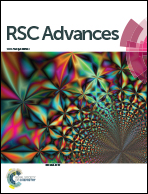Mixed ionic liquid/organic carbonate electrolytes for LiNi0.8Co0.15Al0.05O2 electrodes at various temperatures†
Abstract
Mixtures of N-butyl-N-methyl pyrrolidinium bis(trifluoromethanesulfonyl)imide ionic liquid (IL) and conventional organic carbonate electrolyte are used for high-capacity LiNi0.8Co0.15Al0.05O2 (LNCA) electrodes in Li-ion batteries. Increasing the IL content ratio in the mixtures can increase the electrolyte's thermal stability and retard its flammability. However, the optimal electrolyte composition depends on the operating temperature. At 25 °C, the plain organic electrolyte is preferred due to its highest ionic conductivity among the tested electrolytes. This electrolyte is volatile at 50 °C, and thus the incorporation of 25 wt% IL can improve the cyclic stability of the LNCA electrode. The LNCA dissolution and electrolyte decomposition at 75 °C are clearly suppressed with a high IL ratio in the mixed electrolyte. At such a high temperature, with 75 wt% of IL incorporation a high electrode capacity of 195 mA h g−1 is obtained at 30 mA g−1; 50% of this capacity can be retained when the charge–discharge rate increases to 700 mA g−1. Moreover, less than 20% capacity decay is found after 100 cycles.


 Please wait while we load your content...
Please wait while we load your content...